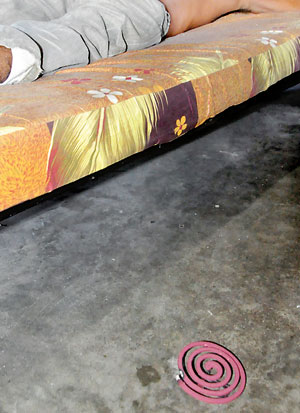News
Toddlers become ‘collateral damage’ of war on mozzies, rats

Negligence and careless disposal of the unburnt parts of coils has resulted in many toddlers consuming the bits and pieces strewn on the floors of their homes. Pic by Nilan Maligaspe
Children are dying from the use of coils and sprays used in households to ward off the mosquito menace.
Health Ministry statistics shows that children as young as one year have been victims of the indiscriminate use of mosquito coils and sprays.
Negligence and careless disposal of the unburnt parts of coils has resulted in many toddlers consuming the bits and pieces strewn on the floors of their homes.
The Toxicology and National Poisons Information Centre (TNPIC) said in 2014 there were 66 inquiries from medical professionals requesting information on the toxicity of the substance and the protocol to be followed to treat patients who ingested it. About 27 of the calls related to toddlers (one to three years old) who had accidentally eaten part of the coil.
TNPIC chief Dr. Warna Gunathilaka said that it was pure negligence on the part of the families that caused these toddlers to consume the coils. Lack of awareness of the toxic nature of the substance caused people to disregard the mosquito coils strewn around the house.
“This is causing harm to children,” he said. Mosquito coils were easily accessible to children.
“The fact that they are always kept at ground level makes it easier for children to reach them,” he said.
In 2014, the TNPIC received 377 calls for help, of which 207 were related to children younger than 14 years consuming common household products such as rat bait, detergents, shampoo, thinner, automobile fluids and Brasso.
After mosquito coils, the next most common toxic substance consumed accidentally by children is rat poison, the TNIC said. In 2014 alone, 15 toddlers had accidentally eaten the substance.
Toddlers are in the habit of placing anything that they can lay their hands on into their mouths. Common cases among toddlers are the consumption of gum, glue and silica gel. Older, schoolgoing siblings carelessly leave gum and glue lying around the house.
Poisoning by silica gel was totally the fault of adults who keep it lying around the house, Dr. Gunathilaka said. (Silica gel is a desiccant that comes packed in sachets and is used as a dehydration agent to preserve leather products, pharmaceutical drugs and other pills.)
Urbanisation has brought many chemicals into homes and the haphazard way these are stored have jeopardised children’s lives, Dr. Gunathilaka said. Frequently used products such as dishwashing liquid, clothes washing powder chalk, thermometer bulbs, Tipp-Ex, rigifoam and camphor balls have been consumed by children.
It has also been found that older children and adults deliberately consume mosquito coils and other substances such as toilet and tile cleaner and rat poison as a means of suicide.
While there is no data on the number of suicide deaths caused by such means the police crime rate abstract says 3,144 people committed suicide in 2014 – 2,484 males and 660 females.
| CMC cautioned over rat poison accidents The Toxicology and National Poisons Information Centre (TPNIC) is concerned that the Colombo Municipal Council is distributing rat poison to Colombo households in a drive to get rid of the rodent population menacing the city. He said rodenticide can be a threat to toddlers in the home environment as the substance can be easily found by children. The TNPIC has received many calls over complaints of humans ingesting rat poison. In 2014, 40 calls were received, and 15 of the victims were younger than three years of age. The municipal council’s Chief Medical Officer, Dr. Ruwan Wijemuni, said officials had taken every precaution, including educating families on the safety measures that have to be taken when handling the rodenticide. “We have informed them about how to use the chemical, the steps that should be taken to store it, and the need to keep it at high elevation out of reach of children,” he said. He said that the households have been asked to lay out the poison at night and store the bait away in the morning. “We have given clear instructions and have also distributed leaflets on the safe use of Clear Rat,” he said. The council is in the process of distributing Clear Rat to 120,000 households, starting with lower-income families. Some 40,000 households have already received supplies. |
Dr. Gunathilaka said the public have become more aware of health hazards in food. “There have been many concerns raised over chemical-smeared food and formalin-contaminated curd,” he said.
“The more educated people are they are concerned about their health.”
The TNPIC has also established a website and can be accessed on facebook to inform and answer questions raised by the public. The addresses are www.toxbase.lanka.info and www.facebook.com/NTPICSL
Information outreach programmes are also being organised in Anuradhapura, the Eastern Province and Badulla at district secretariats, hospital and in schools, Dr. Gunathilaka said.

